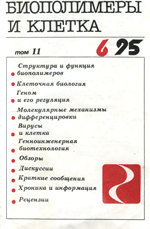The antiviral drug izatizon possesses no mutagenic action and stimulates proliferation of cells of immune system
DOI:
https://doi.org/10.7124/bc.000409Abstract
It has been studied the mutagenic effect of the antiviral drug Izatizon using experimental models. The drug has been shown to possess no mutagenic activity on the level of both chromosome aberrations and gene resistant mutations to 6-mercaptopurine. On a cell culture infected by Herpes simplex virus, type 1, the increase of chromosome aberrations frequency has been observed. Izatizon, being as inhibitor of the viral infection, simultaneously decreased the frequency of chromosome abnormalities. It is been revealed the selective stimulation of cell proliferation on both T-cell culture of CEM-4 line and leukocytes of chicken-Broiler-6, what was correlated with increasing of birds productivity after Izatizon application. Actually, the antiviral effect of Izatizon is due to its influence as on virus-infected cells as on cells of immune system.References
Levinson W. Inhibition of viruses, tumors and pathogenic microorganisms by tzatin-thiosemicarbazone and other thiosemicarbazones. Selective inhibitors of viral functions. Ed. W.A. Carter. London: CRC press, 1973: 213-226.
Indulen MK Chemical inhibitors of viruses and their mechanism of action. Izv Akad Nauk LatSSR. 1972; 9:82-7.
Potopal'skiy AI, Lozyuk LV, Mirolyubova AN, Besarabov BF. Antiviral, anticancer and antileukemia drug izatizon. Kiev: Naukova Dumka, 1991. 192 p.
Rubashevskiĭ EL. Plasmid pBR325tk as a mutagen. Tsitol Genet. 1986;20(1):76-8,
Poster E, Ovod VV, Pozur V K, Vikhot' I. Immunology: Practicum. Kiev: Vyshcha wk., 1989. 304 p.
Rubashevskii EL, Patskovskii IuV, Podol'skaia SV, Sukhorada EM, Lysenko EF, Kostetskaia EV, Kostetskii IE, Varzanova IS, Lukash LL. The induction of mutations in 6-mercaptopurine resistance in Chinese hamster cells under the action of the recombinant plasmid pAins containing the human insulin gene. Tsitol Genet. 1993;27(3):63-8.
Roskin GI, Levinson AB. Microscopic technique. M .: Medicine, 1957: 189-91.
Alov IA. Pathology of mitosis. (Pathological forms, classification, quantitative characteristics). Vestn Akad Med Nauk SSSR. 1965;20(11):58-66.
Bliumkin V. N., Zhdanov V. M. Effects of viruses on chromosomal apparatus and cell division M.: Meditsina, 1973; 17-25.
Klimov NV, Koromyslov GF. The method of quantification of nucleic acids in the blood, its components and tissues of animals. Bull. VIEVM. 1970 issue. 8: 143-8.
Taylor P, Thomas D, Mills L. Lymphocytes. M Mir 1990; 222 p

